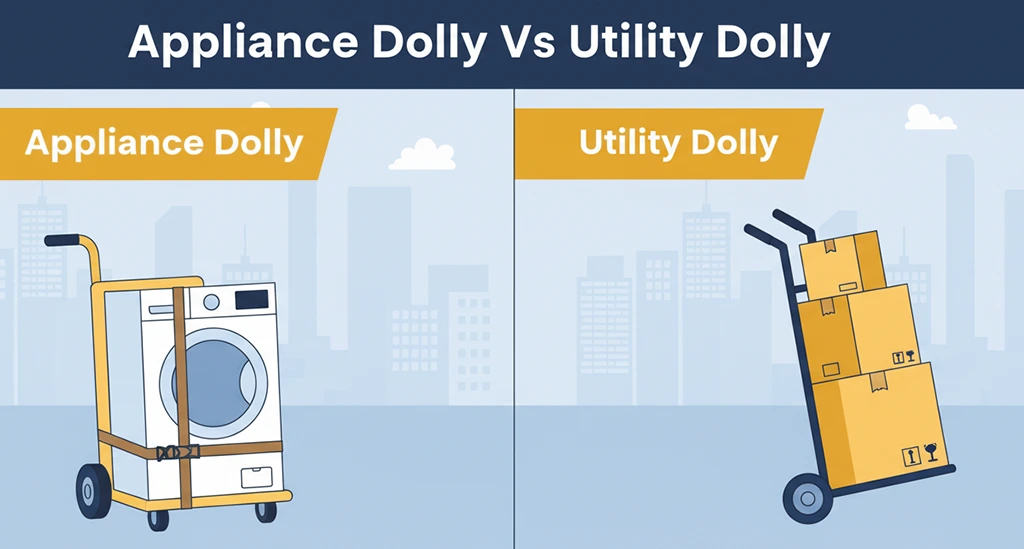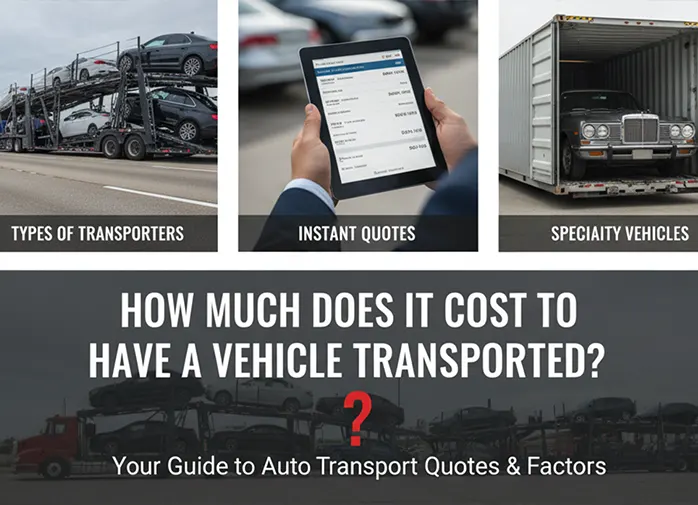Appliance Dolly vs Utility Dolly – Which Moving Tool Do You Need?

When it comes to moving heavy or bulky items, having the right dolly can make all the difference. Two of the most commonly used tools are the appliance dolly and the utility dolly. While they may look similar at first glance, each one is designed for specific types of tasks—and choosing the wrong one can make your move harder than it needs to be.
In this guide, we’ll break down the key differences, uses, pros and cons of each dolly so you can pick the right tool for your moving needs.
What Is an Appliance Dolly?
An appliance dolly (sometimes called a hand truck for appliances) is a heavy-duty dolly specifically designed to move large, heavy items such as:
- Refrigerators
- Washing machines
- Dryers
- Stoves
- Dishwashers
It typically features:
- Straps to secure the appliance
- Rubber wheels that reduce floor damage
- A taller frame for better leverage
- Protective padding to prevent scratches
💡 If you’re moving large household appliances, an appliance dolly is your safest option.
👉 Van Lines Move Tip: Even with the right dolly, appliances can be tough to move safely. Our professional movers are trained to handle heavy appliances without damaging your home or the items themselves.
What Is a Utility Dolly?
A utility dolly, also called a standard hand truck, is a versatile moving tool used for boxes, smaller furniture, and other stackable items.
Key features include:
- A simple L-shaped frame
- Two wheels (sometimes four for convertible models)
- A smaller platform to load boxes
- Lightweight and easy to maneuver
They’re great for:
- Moving multiple boxes at once
- Transporting smaller, lightweight furniture
- General moving tasks
💡 Think of the utility dolly as your go-to for most moving day needs—except for oversized or very heavy appliances.
👉 Van Lines Move Tip: If you’ve got a mix of boxes, furniture, and a few heavier items, our team brings the right equipment—including both utility and appliance dollies—so you don’t have to worry about renting.
Appliance Dolly vs Utility Dolly: Quick Differences
|
Feature |
Appliance Dolly |
Utility Dolly |
|
Best For |
Large appliances (fridges, washers, stoves) |
Boxes, small/medium furniture |
|
Weight Capacity |
600–800 lbs |
300–600 lbs |
|
Straps |
Yes, built-in |
No |
|
Frame Height |
Taller for leverage |
Shorter and lighter |
|
Protection |
Rubber wheels, padding |
Basic wheels, no padding |
|
Cost to Rent |
$10–$15/day |
$8–$12/day |
Bottom Line: Use an appliance dolly for heavy, tall, and fragile appliances. Use a utility dolly for boxes, bins, and smaller furniture pieces.
👉 Van Lines Move Tip: Not sure which you need? Our movers always evaluate your items in advance and bring the right dollies and tools for a smooth move.
Appliance Dolly vs Utility Dolly: In-depth Differences
Best For
An appliance dolly is built for the toughest moving tasks—transporting large, bulky, and heavy household appliances. Items like refrigerators, washing machines, dryers, and ovens fit perfectly because the dolly is tall enough to support the full height of the load and comes with straps to hold it in place. By contrast, a utility dolly is more of an all-purpose tool. It works best for moving boxes, totes, smaller furniture, or stackable items. Its design makes it easy to load several boxes at once, saving trips back and forth, but it simply isn’t designed to handle extremely heavy appliances safely.
Weight Capacity
One of the biggest differences lies in how much weight each dolly can handle. An appliance dolly is engineered to carry very heavy loads, often supporting between 600 and 800 pounds with stability. This makes it ideal for appliances that can weigh several hundred pounds each. A utility dolly, on the other hand, usually supports a lighter range, typically between 300 and 600 pounds. While that’s still strong enough for stacked boxes or a dresser, overloading it with heavier appliances could cause damage to both the dolly and the items being moved.
Straps
Appliance dollies always come with built-in straps that act as a safety harness for your load. These straps prevent large appliances from tipping, sliding, or shifting while the dolly is tilted back and rolled. Without them, it would be nearly impossible to move a tall refrigerator without risking it falling over. Utility dollies do not have straps, since they’re intended for lighter, stable loads like boxes. That means if you try moving taller items, you’d need to add your own ropes or bungee cords to keep things steady—but it still won’t match the built-in security of an appliance dolly.
Frame Height
The frame height is another key difference. An appliance dolly has a much taller frame—often extending past the top of a refrigerator. This height provides leverage, letting movers tilt and control large objects with less effort. It also prevents the load from towering dangerously over the dolly. By comparison, a utility dolly has a shorter frame, just high enough to stack boxes or a few small pieces of furniture. Its compact size makes it easier to maneuver in tight hallways or up stairs, but it offers little support for tall or bulky items.
Protection Features
Because they’re designed for heavy and often expensive appliances, appliance dollies usually come with protection features like rubber or non-marking wheels, padded backs, and even stair climbers on some models. These protect both the appliance and your floors during transport. A utility dolly is much simpler: it usually has basic rubber or pneumatic wheels but no padding or added protection. That’s fine for cardboard boxes, but risky if you’re moving a stainless-steel fridge that could easily scratch.
Cost to Rent
Rental cost is another factor people consider. Appliance dollies typically cost slightly more to rent—usually around $10 to $15 per day—because they’re specialized equipment. In contrast, utility dollies are cheaper, ranging from $8 to $12 per day, and are more widely available since they’re considered a general-use moving tool. While the price difference is small, using the wrong dolly can lead to costly damage, so it’s better to pay a few extra dollars for the right tool if you’re moving heavy appliances.
Pros and Cons of Each Dolly
Appliance Dolly
Pros:
- Handles very heavy loads
- Straps secure items in place
- Safer for floors and appliances
Cons:
- Heavier and harder to maneuver
- Limited to appliances and large furniture
Utility Dolly
Pros:
- Lightweight and versatile
- Moves multiple boxes at once
- Easy to use in tight spaces
Cons:
- No straps for securing items
- Not safe for tall or very heavy appliances
Safety Tips When Using a Dolly
- Always secure appliances with straps on an appliance dolly.
- Keep the load balanced and centered on the platform.
- Use two people when navigating stairs or tight corners.
- Wear gloves and closed-toe shoes for protection.
- Never overload beyond the dolly’s weight capacity.
👉 Van Lines Move Reminder: Professional movers don’t just bring the right equipment—they bring the expertise to use it safely. If you’re worried about injury or damage, let us handle the heavy lifting.
Final Thoughts: Which Dolly Should You Use?
- Choose an appliance dolly if you’re moving heavy household appliances.
- Choose a utility dolly for boxes and smaller furniture.
- For most moves, you’ll likely need both to handle different tasks.
If you want to save time, effort, and potential damage, consider hiring a professional moving company like Van Lines Move. We provide the right equipment, skilled movers, and full-service options so your relocation is stress-free from start to finish.
Frequently Asked Questions (FAQ)
1. What is the difference between an appliance dolly and a utility dolly?
An appliance dolly is built for tall, heavy items like refrigerators and comes with straps and stair glides. A utility dolly is a lighter, more versatile hand truck ideal for boxes and smaller furniture.
2. Can I use a utility dolly for a refrigerator?
No. Refrigerators should stay upright and require straps for stability—use an appliance dolly instead.
3. How much weight can a moving dolly hold?
Utility dollies usually hold 400–600 lbs, while appliance dollies can handle 600–800 lbs.
4. Is it better to rent or buy a dolly?
For a one-time move, renting is cost-effective. If you move often or run a business, buying may be a better long-term investment.
5. Do I really need both dollies for moving?
Not always, but many movers rent both. Use the appliance dolly for big appliances and the utility dolly for boxes and smaller furniture.
Categories
- Long Distance Moving153
- Local Moving119
- Commercial Moving40
- Residential Moving34
- Last – Minute Moving25
- Moving Tips & Lifestyle10
- Furniture Moving9
- Moving Tips & How-To Guides8
- Moving services6
- Moving Cost5
- Moving Cost Calculator5
- state to state movers4
- Piano Moving3
- Car Transportation3
- Truck Rental3
- moving tips3
- Local Move3
- Moving companies3
- best moving rates3
- cheap moving companies3
- affordable moving companies3
- full-service movers3
- Moving Cost Guides3
- Junk Removal2
- Moving Container2
- Senior Moving2
- Senior Relocation Moving Companies2
- Moving Tools2
- Moving Estimates2
- interstate moving2
- Moving2
- cross-country move2
- Household moving2
- Moving Costs & Budgeting2
- Moving Tips & State Guides2
- Heavy Equipment1
- Senior Moving Services1
- office moving1
- office relocation1
- employee relocation1
- Car Transport1
- Vehicle Shipping1
- Car Shipping Services1
- Artificial Intelligence1
- Office Moving Services1
- Commercial Moving Companies1
- Corporate Moving Services1
- Corporate Movers1
- full-service moving companies1
- sustainable moving companies1
- green movers1
- Moving in US1
- Best places to move in 20251
- 2025 moving1
- Full-Service Moving Companies1
- College Moving1
- College moving services1
- Moving to College1
- Dorm Moving1
- Tips for moving1
- donate1
- sell1
- Movers in California1
- Movers in Studio City1
- Moving to California1
- Laws about Moving into California1
- Moving Laws1
- House moving1
- packing1
- cheap moving ways1
- Moving guide1
- International moving1
- moving across countries1
- international relocation program1
- move out cleaning1
- right packing supplies1
- pack while moving1
- Apartment moving1
- PODS1
- moving out1
- state to state move1
- California movers1
- Truck Rental1
- US Territory Relocation1
- International Moving1
- Shipping & Moving Tips1
- Moving Tips1
- Relocation Guide1
- Moving Budget Guide1
- Relocation Guides & Incentives1
- Moving Tools & Equipment Guides1
- Moving Services & Options1
- Moving Tips & How-To Guides1
- Moving Day & Settling In1
- Mobile Home Moving1
- Moving Guide & Tips1
- Moving Tips & State Comparisons1
- Moving Tips & City Guides1
- Moving Tips & Cost Guides1
- Long-Distance Moving Tips1
- Moving Tips & Financial Planning1
- Moving Tips & Home Preparation1
- Moving Tips & Planning1
- Vehicle Shipping & Auto Transport1
- Marketing & Lead Generation1
- International Moving Guides1
- San Francisco Moving Guide1
- NYC Moving1
- Local Movers1
- Budget Moving1

 Local Movers
Local Movers Last-Minute Movers
Last-Minute Movers Junk Removal
Junk Removal Long Distance Movers
Long Distance Movers Piano Movers
Piano Movers Heavy Equipment
Heavy Equipment Commercial Movers
Commercial Movers Moving Container
Moving Container Car Transportation
Car Transportation Furniture Movers
Furniture Movers Truck Rental
Truck Rental Moving Cost Calculator
Moving Cost Calculator Moving Planner
Moving Planner Packing Calculator
Packing Calculator Moving Checklist
Moving Checklist Moving Insurance
Moving Insurance FAQ
FAQ Contact Us
Contact Us Moving Loan
Moving Loan About Us
About Us











